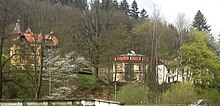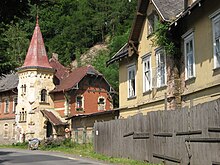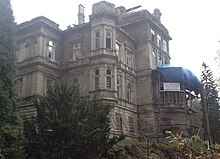Kyselka (Kyselka)
| Kyselka | ||||
|---|---|---|---|---|
|
||||
| Basic data | ||||
| State : |
|
|||
| Region : | Karlovarský kraj | |||
| District : | Karlovy Vary | |||
| Municipality : | Kyselka | |||
| Area : | 75.7999 ha | |||
| Geographic location : | 50 ° 15 ' N , 13 ° 0' E | |||
| Height: | 582 m nm | |||
| Residents : | 34 (2001) | |||
| Postal code : | 362 72 | |||
| License plate : | K | |||
| traffic | ||||
| Railway connection: | Vojkovice nad Ohří – Kyselka | |||
Kyselka , until 1950 Kysibl Kyselka , (German: Gießhübl Sauerbrunn ) is a former spa town in the Czech Republic . Today it is part of the eponymous municipality of Kyselka in the Karlovy Vary region . Kyselka was built on both sides of the Eger and is inhabited by 153 people (as of 2010). The buildings in the southern half of the village around Villa Mattoni are mostly in need of renovation and have been restored since 2013 .
Kyselka used to belong to the health resorts of Austria-Hungary and later Czechoslovakia . Until after the Second World War he lived mainly from the spa business and today from bottling mineral water from the Mattoni brand .
The five mineral springs in the village are rich in carbonic acid and mineral salts and are part of the Mattoni company. The mineral water is recommended for drinking cures and treatments for respiratory, metabolic and kidney diseases and pain in the musculoskeletal system.
Surname
The name of the settlement Gießhübl is said to have been mentioned for the first time in 1612. Until the end of the 19th century, the double name Gießhübl-Puchstein and then Gießhübl-Sauerbrunn is documented. The official Czech name has been Kyselka since 1950 .
geography
Kyselka is located at the foot of the Ore Mountains and the Duppau Mountains in the Okres Karlovy Vary in the Karlovy Vary Region (Karlovarský kraj). The place is located at the confluence of the Lomnice in the valley of the Eger , which divides it into a north and a south part. The highest point of the place is 582 m above sea level. M.
surface
The area of the municipality of Kyselka is 6.48 km², with approx. 0.3 km² in the district of Kyselka. About one and a half thirds of the area of the former spa are built over, another third is wooded and the rest is water.
Flora and fauna
About two quarters of Kyselkas are forested. The original beech forest as far as Karlsbad has given way to a mixed forest with oak , maple and spruce in some places , as much of the forest has fallen victim to the castle park . In the higher elevations of the health resort area, there is a coniferous forest with spruce and larch .
Foxes , badgers , wild cats and lynxes live in the park today . Numerous species of birds can also be found in the overgrown area. As part of the restoration work since 2013, the park and the entire surrounding area have been placed under nature protection.
climate

|
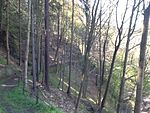
|
|
|
Vegetation of the Kyselka Castle Park
|
||
Kyselka is located in the temperate climate zone . The mean annual temperature is around 8 ° C, minus values in winter last reached (around 1990) down to −12 ° C, plus values in summer up to 30 ° C. Most of the precipitation falls in June and July, the winter half-year is relatively dry until February.
Since a violent thunderstorm in 1987, it has been observed that the amount of precipitation here is constantly increasing and that heavy rains are more frequent than before.
history
prehistory
The main source of the town, formerly also known as Buchsäuerling, is mentioned for the first time in a document by Wenceslaus Payer in 1522 . There is evidence that in 1614 the area around Kyselka was fenced in, and that drinking water had to be paid for. Only in 1687, when a Count Czernin von und zu Chudenitz visited the area at the foot of the Buchkoppe , his subjects were allowed to drink the mineral water free of charge. In 1793, Count Johann Josef Stiebara von Buttenheim bought the area and began to export the water. He sold the water, delivered it to cities such as Vienna , Prague and Karlsbad and founded Kyselka as a modern health resort around 1792/93.
The first bathhouses in the village were built between 1826 and 1834, were very modern and were largely financed by the German aristocrat Wilhelm von Neuberg , who was the liege lord of Gießhübel from 1829. The popularity of both Kyselkas and its tasty water increased and in 1852 the Greek King Otto I was a guest, in whose honor a bath of the place was named.
Mattoni era and the interwar period
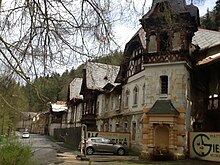
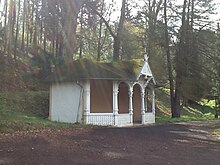
In 1867, the Italian- and German-born entrepreneur leased Heinrich Mattoni (1830-1910) the source with the biggest bed that Otto source. He began by filling the water in glass bottles and offered it first in Bohemia, later in the rest of Austria-Hungary and finally throughout Europe . In 1876 the Mattoni company had sold over a million bottles. With the massive profits from the sale and on the advice of Doctor Josef von Löschner , Mattoni bought the surrounding land. Little by little he expanded the place until his death, including a new colonnade, a sanatorium, a hydropathic institute , several hotels, restaurants, shops and a chapel. Due to the increasing popularity of Kyselka, Czech and German Jews came to the place and formed a small community that later had a strong influence on the place and made up a third of the population. The larger sections of the population began to inspire each other and several German hotels, Jewish coffeehouses and Czech spa houses were built . In 1894 Emperor Franz Joseph I visited the place. When Mattoni died in 1910, the community honored him with a memorial in 1914 . Despite the First World War , the number of visitors and residents grew. In 1918 the place was claimed by the Republic of German Austria , but attached to Czechoslovakia when the Czechoslovak Army occupied the place in 1919. The health resort ceased in 1920 and was revived in 1923. In 1928 the health resort had 540 inhabitants and a small Jewish cemetery was established. In the 1930s, the number of spa visitors and residents rose sharply, with the proportion of Czechs in the population falling.
Munich Agreement and World War II
With the Munich Agreement in 1938, the health resort fell to the German Reich and became part of the Reichsgau Sudetenland . The local Jews and Czechs were expelled. The synagogue , inaugurated in 1925, was destroyed during the Night of the Reichspogrom in November 1938 and the Jewish cemetery in 1939. Nevertheless, the population increased sharply. In 1944 there were brief skirmishes between residents and Czech partisans in the village. In April 1945 the SS settled German refugees from Poland in the village. In May, the health resort had 600 inhabitants, around 95% of whom were of German nationality. Before the end of the war there was fighting between Czech partisans and German residents. The last German officials left the place on May 5th. On May 7, 1945, the place came under Czech control. Later the Red Army and US forces occupied the place and divided it up along the Eger . The Red Army received the northern part and the US forces received the southern part. By 1947, Kyselka had two mayors, each appointed by the Soviet and American occupiers.
Post-war period and part of Czechoslovakia

After the war, around half of the German population was expelled and Kyselka was repopulated. Most of the local Jews survived the Holocaust and about 110 of them returned. Roma and Czechs were quartered in the empty houses . A refugee camp for orphans from the Greek civil war was set up in the Mattoni villa for a short period of time ; this was closed in 1952. During the time of the Stalinist terror , seven residents of Kyselka were arrested, four of whom were executed. The local businesses were initially excluded from the large nationalizations in the Czechoslovak Republic and only became publicly owned in 1957 . Until 1990 the health resort belonged to the Czechoslovak state spas. In the 1960s, Kyselka was evacuated and assigned to the Hradiště military training area . After the site proved unsuitable for this purpose, people were resettled in the village again. All the remaining inhabitants left the district south of the Eger in the course of the 1970s / 80s and gave up this and their businesses there. In 1990 the process of privatization was decided, but this had no effect, so that gradually many buildings fell into disrepair.
1993 until today
After privatization, the facilities became the property of the National Property Fund of the Czech Republic ( Fond národního majetku České republiky ), which cleaned the clogged mineral water springs. In 1994 a German-Russian company (headed by US Chalitujev) became aware of the place and bought the former coffee house . The company planned its complete restoration, which was also started. In 1997 it broke off this project because its plan to turn Kyselka into a large, luxurious entertainment and leisure center had failed due to a lack of funds. As a result, this building also fell apart again.
Most of the decayed buildings belong to RIS (Revitalizační investiční společnost), the rest of the buildings, together with the majority from Spaland, belong to the company Karlovarské mineralní vody (bottler of Mattoni mineral water). Since 2010 the administration of Karlovy Vary has been putting constant pressure on the company and demanding that the buildings be sold.
The owners have repeatedly promised to rebuild the place, but after the recent changes it is clear that this has been neglected. Although some politicians are calling for the town to be liquidated, the civil resistance has so far managed to reinstate the monument protection, which was lifted in 2011 and allowed the buildings to be demolished, and the spa facilities have been protected since March 2012.
The last owner of the RIS sold the place in January 2012 for 17.5 million Czech crowns .
The Association for the Preservation and Development of Cultural Heritage (ASORKD) decided on February 13, 2011 to start a campaign to save Kyselka and to promote the expropriation of the previous owners of the buildings. Then they began to raise public funds to finance the rescue of the site and sought state subsidies. With support from the media, the collection of 27,000 signatures and a financial donation from a company, the site was able to attract more public attention for the first time since the 1970s. But the ASORKDU faced further challenges. When President Václav Klaus visited the site, he rejected nationalization, but over time public interest in saving the building grew and prominent personalities such as the actor and director Ladislav Smoljak and the ombudsman Otakar Mattoni , a great-grandson of Heinrich, visited Mattonis, the place.
In 2013, a process of reconstruction was finally decided by the authorities, according to which only a few buildings were to be reconstructed and the remaining ones to be demolished. Ultimately, this plan was abandoned and almost all buildings are to be reconstructed with financial help from sponsors. In the autumn of 2013, Haus Stalburg was the first building to be completely restored. The reconstruction of the Mattoni-Villa, the Rudolf-Quelle and the theater is progressing slowly. Further building renovations are being planned, whereby the former fire station will be demolished and a small park will be created. It is planned that Kyselka will become a health resort again, with around 600 inhabitants. However, the rehabilitation status of the place is still bad. The buildings are now partially protected from the forces of nature and the mineral springs are gushing again.
Coat of arms of the district
The district of Kyselka has its own coat of arms. It is divided into two broad fields in the colors yellow and red. On the yellow side there are two hexagonal stars with an anchor, which is entwined by a snake, in the middle. Below the yellow half there is a lion, the so-called Gießhübler lion , on the red half . Mineral water flows out of the mouth and forms a small pond below.
The coat of arms of the village is depicted on many buildings in the Kyselka district and is a modified version of the coat of arms of the Mattoni family . It was declared the official municipal coat of arms around 1880 and was first attached to a building around 1890.
Residents
Ethnic groups
Before the Second World War, mostly Czechs , Germans and Jews lived in the place (a third of the population at that time). In 1945/46 many Germans were expelled and some Jews emigrated to Israel . After the Second World War, Roma , Croats , Bulgarians , Ukrainians and Russians were temporarily settled in order to compensate for the population loss, but disappeared at the latest with the eviction in the 1960s. From the 1970s to the 1980s, Roma inhabited the place again and at times made up the second largest ethnic group. Roma families who moved again at the end of 2007 were resettled in 2013. Today mostly Czechs live in the place.
Religions

The range of religions represented in the spa formerly included both Judaism and the Christian faiths Protestantism , Catholicism and Orthodoxy ; from 1930 the Czechoslovak Hussite Church was also represented.
Population development
The population development of the place was strongly influenced by historical changes. The population grew rapidly until 1918, but decreased after the collapse of Austria-Hungary . From 1928 the population rose again. The population, initially decimated by the expulsion of the Czechs and Jews following the Munich Agreement, grew again from 1942 and reached a peak in 1945 with 600 inhabitants. The population did not recover from the expulsion of the Germans from Czechoslovakia , but has continued to decline since then. In 1991 the place had 54 inhabitants. In 2001, Kyselka consisted of 13 houses in which 34 people lived. In 2010, Kyselka had about 153 inhabitants.
- Population of Kyselka
| year | 1910 | 1914 | 1920 | 1928 | 1930 | 1939 | 1945 | 1947 | 1959 | 1972 | 2010 |
| Residents | 455 | 579 | 530 | 540 | 552 | 535 | 600 | 297 | 230 | 160 | 153 |
age structure
In 2010, the majority of residents were over 50 years old. Around 15% of the population was under 18. The average life expectancy in the health resort has been around 73 years since 1990.
economy
Kyselka used to be the economic center of the area. There were 27 hotels, several cafes and shops in the village. There were also three banks in town. The comparatively low tax rates resulted in a high quality of life.
In the 1920s in particular, the economy was very much geared towards the service sector, in which almost 60% of the population was active. Around 20% of the population worked in the industrial sector and less than 10% in agriculture. The remaining 10% probably worked outside of town.
Health resort
In the past, the spa guests played a decisive role in the local economy. The money they left in the village made some residents wealthy who used part of the income to maintain their houses. From 1910 to 1914, the spa had around 2500 visitors per month. Their number grew to around 4500 to 5500 guests by the beginning of the First World War. The influx fell sharply from 1918, but peaked again in 1928. After the Munich Agreement came into force, the number of visitors fell again and most of the guests stayed away until 1945. From 1946 and 1947 the place was mainly visited by Russian and Ukrainian guests. Then the influx stopped completely. Today there is no tourist infrastructure worth mentioning in Kyselka and no spa guests.
Industry
There used to be a few smaller porcelain factories in the spa and Karlovy Vary wafers and Becherovka liqueur were also made here. When the spa business went out and the nationalizations in the 1950s, these businesses died.
Today there is still the beverage manufacturer mineral water bottling ( Mattoni brand ) in the village .
Today's tourism
The place has been regularly visited since 2012. Often there are onlookers from Germany or Austria . But there are also those from large parts of the Czech Republic who come to the water sources. The area is also popular with interested Slovak and Hungarian architects. In 2013, Czech and Israeli Jews visited the site. Since 2013 bus travel companies have been offering tours through Kyselka. On one day in spring 2014, the site was visited by around 750 people at the same time as part of an event.
traffic
The Vojkovice nad Ohří – Kyselka railway , through which Karlovy Vary can also be reached , runs through Kyselka .
The expressway to Radošov runs through the spa . There are also several smaller paths and two bridges that cross the Eger River .
There is a bus line to Kyselka. There used to be a funicular for the spa guests and a tram. Until 1948 there was a cycle path laid out in 1919, also for the spa guests.
politics
Until 1942 Kyselka did not have a mayor, but a seven-member council. In 1945 this was briefly re-established but then replaced by a mayor. Due to the division of the town, an American mayor was installed in the south and a Soviet mayor in the north. The Kyselka Municipal House has been located in Kyselka since 1987. Aleš Labík has been the mayor since February 2012.
Community finances
The Kyselka municipality takes care of the entire financial development of the surrounding municipalities. The economic center of the municipality is Kyselka. In the south and north-west of the district there are several companies that employ a large part of the residents of the entire municipality and the surrounding areas.
Around 2006, Lázně Kyselka had the lowest tax rate in the area. The local debt in 2007 was above the average in Okres Karlovy Vary .
The Czech government plans to provide around 750 million kroner for the restoration measures in 2014 .
Culture

Influences from Austria-Hungary , Czechoslovakia , France , the United Kingdom , Germany , Italy and the United States have been integrated into Kyselka's culture at all levels. This had its origin in the popularity of the place. In the inter-war period alone, people from over 20 nations settled here . Today, however, there is hardly anything left of the cultural diversity.
Sports
Kyselka offered its spa guests sporting activities in the late 1920s and 1930s. Golf and horse riding were the most popular sports in the area. In particularly cold winters, you could skate and play ice hockey on the Eger .
In the late 1940s, Kyselka's last spa guests from the Soviet Union enjoyed walking and cycling.
Film and theater
There were a total of three cinemas in the health resort , including a luxurious movie theater, which Franz Joseph I also visited in 1910. Mattoni had short films and advertising films made in the village, which were also shown there.
There used to be great interest in the local theater ; his repertoire encompassed the full range of classical and contemporary drama in translations, as well as plays by local authors. Especially in the 1930s, operas were also on the program in the theater. Smaller opera pieces were performed there until around 1960 and there was a theater company in town until 1970.
Fine arts and museums
There were amphoras, statues and luxury gardens in Kyselka, the buildings were architecturally elaborate and the castle park was well-kept. Very few public works of art exist today.
There were two smaller art museums and a local museum in the village . Today a museum is dedicated to the Mattoni brand.
swell
Geologically, the headwaters around Kyselka are in the Ore Mountains in the Bohemian Massif . In this area there are paths for rising water; Mineral springs and thermal springs were created especially in connection with volcanism . If the sources are naturally enriched with CO 2 , they are referred to as sourlings , if the gas escapes directly, they are mofettes .
Often the springs contain iron, which affects the taste of the spring water on the one hand, and iron hydroxide (Fe (OH) 2 ) precipitates on contact with atmospheric oxygen (O 2 ) due to oxidation of the divalent iron (Fe 2+ ) dissolved in the water . Since the deep waters are oxygen-free, there is no microbial contamination.
In addition to iron, other minerals are usually also dissolved. Usually, metamorphic rocks give off these only to a lesser extent. Due to the flow of water containing CO 2 through the rocks, i.e. an acidic solution, this process is made easier. Kaolinisiertem from albite, a feldspar originate for example sodium and calcium , from serpentinite , however, can increasingly magnesium dissolved and accumulated in the water.
The former health resort has a total of five water sources: Kaiserin-Elisabeth-Quelle , Otto-Quelle including Mattoni-Quelle , which existed until 2014 , Kaiser-Franz-Josef-Quelle , Rudolf-Quelle and Löschner-Quelle .
Attractions
- The Villa Mattoni was built in 1867 and was Mattoni's residence until his death in 1910. After his death it was used as a school and was owned by a German family during World War II. After the Second World War, the historic building became a children's home for orphans from the Greek Civil War . In 1960, a military base was set up in the building's spacious basement complex. Restoration work has been carried out since May 2013. In the park is the wooden spa pavilion and parallel to the street is the protected lime tree avenue .
- Haus Stalburg is a castle-like building that was built around 1870. It has had several owners in its history and was nationalized in 1957. The building was restored between 2013 and 2014, with an additional extension causing strong criticism.
- The Kyselka Theater opened in 1894 and was used as a theater until 1934/35, after which it served as a cinema and was closed in 1939. Then the German newsreel was broadcast in the theater. The theater reopened in 1945 and closed in 1972. It has been under restoration since 2014 and has been declared a monument.
- The Mattoni monument was erected in 1914 to honor Heinrich von Mattonis . In 2013 the weeds were removed from her and she was derusted.
- The synagogue in Kyselka was inaugurated in 1925 and fell victim to the Reichspogromnacht in November 1938 . After the Second World War it was rebuilt in 1948, but fell into disrepair in the 1950s. In 2013 the sacred building was placed under monument protection.
- Castle Park of the Mattoni Villa ; the park encompasses the entire forest, with the historical boundaries still preserved. In 2013, many of the newly grown trees were felled.
Personalities

Honorary citizen
- Heinrich von Mattoni (mineral water entrepreneur and founding father of the modern spa)
- Josef von Löschner (aristocratic Bohemian bath doctor)
- Eduard Bruna (founder of the Prager Tagblatt )
- Chaim Elazar Spira ( Carpathian Russian rabbi who visited the place several times)
- Edmund von Hellmer ( Austrian sculptor, creator of the Heinrich von Mattoni statue in the village in 1914)
- Wilhelm von Neuberg (from 1829 liege lord of the Gießhübl lordship)
Well-known spa guests
- Franz I of Austria (first Emperor of Austria )
- Elisabeth of Austria-Hungary (Empress of Austria-Hungary )
- Franz Joseph I (Emperor of Austria-Hungary)
- Charles I (last emperor of Austria-Hungary)
- Wilhelm II (last emperor of the German Empire )
- Rudolf of Austria-Hungary (son of Emperor Franz Joseph I and Empress Elisabeth)
- Otto I of Greece (first king of Greece )
- Mohammad Reza Pahlavi (last Shah of Iran )
- Haile Selassie (last Ethiopian Emperor of Abyssinia )
- Tomáš Garrigue Masaryk (first President of Czechoslovakia )
- Charlotte Garrigue (Mrs. Tomáš 'Garrigues Masaryks)
- Edvard Beneš (second President of Czechoslovakia)
- Nicholas II (last tsar of the Russian Empire )
- David Farbstein (second Jewish National Council of Switzerland )
- Johann Wolfgang von Goethe (German poet)
- Otto von Bismarck (first Chancellor of the German Empire)
- Chaim Weizmann (first President of the State of Israel )
literature
- Anton Gnirs : Topography of the historical and art-historical monuments in the Karlsbad district (Prague 1933) (= Handbook of Sudeten German Cultural History. 8). Published by the Collegium Carolinum . Obtained from Anna Gnirs. Oldenbourg, Munich 1996, ISBN 3-486-56170-7 , p. 39.
- Ingrid Haslinger: Customer - Kaiser. The story of the former imperial and royal purveyors. Schroll, Vienna 1996, ISBN 3-85202-129-4 .
- Josef von Löschner : Contributions to balneology. In: Quarterly for practical medicine. Vol. 3 = Vol. 11 of the whole series, 1846, ZDB -ID 547299-4 , pp. 131–152, here pp. 132–152 .
- Josef von Löschner: The spa town of Gießhübl in Bohemia, with special consideration of the benefits and use of the mineral water it sends out. 7th, increased edition. Mattoni & Knoll, Karlsbad 1871, ( digitized ).
- Wilhelm Gastl: The health resort of Gießhübl-Puchstein near Karlsbad and its sources (= European hiking pictures . 156/157, ZDB -ID 253927-5 ). Orell Füssli, Zurich 1889.
Web links
- Zachraňte lázně Kyselka!
- Mattonky se po 15 letech vrací na koleje. Vlaky je začnou vozit na Moravu
- ceskatelevize.cz
- Lázně Kyselka
- radio.cz
- zachrante-lazne-kyselka.cz
- Lázně Kyselka v roce 1928 (Gießhübl-Sauerbrunn in 1928) contemporary video from YouTube
Individual evidence
- ↑ http://www.uir.cz/katastralni-uzemi/678678/Kyselka
- ↑ Předpis č. 13/1951 Sb.
- ↑ Information from the Czech Office for Statistics, Census and Housing , October 22, 2010
- ↑ An overview of the history of Mattoni mineral water and its influence on Kyselka at www.humintel.com/Mattoni.pdf
- ^ Entry in: Meyer's large conversation lexicon. Volume 7: Franzensbad to Glashaus. 6th, completely revised and enlarged edition. Bibliographisches Institut, Leipzig et al. 1907, p. 835 ; Meyer's entry refers to Josef Löschner: The Curort Giesshübl-Sauerbrunn near Karlsbad in Bohemia. With preferential consideration of the use and use of Mattoni's Giesshübler Sauerbrunn (= Braumüller's bathing library. 13). Revised by Wilhelm Gastl. 13th, increased edition. Braumüller, Vienna et al. 1899, referenced.
- ↑ http://www.uir.cz/obec/555347/Kyselka on www.obecKyselka
- ^ Johann Gottfried Sommer: The Kingdom of Bohemia; Represented statistically and topographically. Volume 15: Elbogner Kreis. Friedrich Ehrlich, Prague 1847, p. 152 .
- ↑ a b History of Kyselky v datech. Obec Kyselka, May 11, 2009, accessed on May 11, 2009 (Czech, Gießhübl story with a picture of the Mattoni monument).
- ↑ zachrante-lazne-kyselka.cz
- ↑ Josef Smola: Zoufalí nájemníci: Žijeme v domě hrůzy ( Memento of 20 October 2010 at the Internet Archive ). On September 19, 2010 on sip.denik.cz
- ↑ Alexandra Mostýn: The pressure is growing . On September 5, 2012 on landeszeitung.cz
- ↑ ekonomika.idnes.cz
- ↑ a b konektor.biz
- ↑ camic.cz ( Memento of the original from April 16, 2014 in the Internet Archive ) Info: The archive link was inserted automatically and has not yet been checked. Please check the original and archive link according to the instructions and then remove this notice.
- ↑ Fotky lázní for ptačí perspektivy. Zmar, zlost a bezmocnost. . On January 20, 2013 on zachrante-lazne-kyselka.cz
- ↑ http://www.czso.cz/csu/2009edicniplan.nsf/t/010028D080/$File/13810901.pdf
- ↑ www.obeckyselka.cz
- ↑ www.obeckyselka.cz




